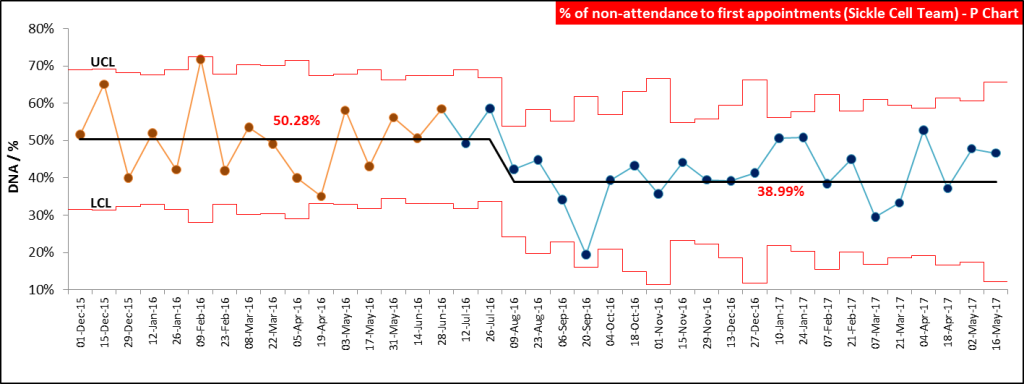
Improving Access in Children’s Services
11th July 2017
The Sickle Cell and Thalassaemia Service
The Sickle Cell and Thalassaemia Service started their QI project in December 2015. The service dedicates time every Friday afternoon to focus on quality improvement and this time has involved teaching sessions on the methodology, presentations and project team meetings. All members of the service are part of the QI project team and this includes, nursing staff, administrative staff, student nurses and service users.
When they initially started the QI project they were focused on reducing waiting times with a large aim to improve all pathways in their service by achieving the following:
- 90% of 0-5 years children have been referred to the service and seen within the 10 working days.
- 89% of children 0-5 have received combined health visiting and nursing assessment and care plan by March 2016.
- 99% of the children 0-5 would have commenced treatment and treatment adherence monitoring 4-6 weeks to 5 years by March 2016.
- 90% of the parents of those children to have received counselling, education with regards to their baby by March 2016
They developed detailed process maps for each of the pathways involved and manually collected extensive data. During one of their QI project team meetings they spent time reviewing the different process maps and identifying areas of particular concern. The team expressed that many of the delays in their processes were dependent on external services for example receiving blood results. Through the use Nominal Group Technique and Affinity Diagram the team highlighted that they were most concerned about referrals that they receive for service users who are over twenty weeks of gestation due to the limited amount of time available to ensure all tests are complete, results received and the service user is able to make an informed decision.
The team reviewed their aim and decided to focus on seeing all women over 20 weeks of gestation but under 22 weeks and 6 days within 48 hours (2 working days) of receiving the results/referral. The team decided to test an emergency clinic and they predicted that this would enable them to be able to offer appointments to any referrals received over 20 weeks of gestation but under 22 weeks and 6 days. The emergency clinic slot took place twice a day, morning and afternoon on Tuesday, Wednesday and Thursdays. They tested this for one week and then decided to send a text message reminder. The team tested different ways to word the text message reminders and finally decided to send text messages that emphasised the importance and urgency of the appointment. Through multiple PDSA cycles the team also developed a plan for those who DNA and were able to identify those who the clinic would not be suitable for.
The team went on to change the wording of the text message reminders sent to all ANC (Ante Natal Clinic) first appointments to be similar to the texts sent for the emergency clinic appointments. Following the change in text message reminders and the introduction of emergency clinics the team achieved a fantastic 22% reduction in first appointment non-attendance. This improvement in DNAs has been sustained for since August 2016.
The team went on to test the same text message wording with all follow up appointments and this resulted in a remarkable 43% reduction in DNAS. The team are now collecting qualitative feedback on services user’s thoughts regarding the text message wording and are in the process of writing up their project for publication.
The QI Project team also produced a poster based on their project which they presented at the 2017 Annual QI Conference in London. View their poster by clicking the image below
The Sexual Health Service
In addition to the Sickle Cell and Thalassaemia Service another Children’s service has been working on reducing DNAs as part of the Improving Access to Services Learning system. The Sexual Health Team has also tested text message reminders and has achieved a 21% reduction in non-attendance for their specialist clinics.
Most Read Stories
-
Why is Quality Control important?
18th July 2018

-
An Illustrated Guide to Quality Improvement
20th May 2019

-
2016 QI Conference Poster Presentations
22nd March 2016
-
Recognising Racism: Using QI to Help Take Action
21st January 2021

-
Using data enabled us to understand our problem
31st March 2023

-
QI Essentials: What does a Chief Quality Officer do?
18th March 2019


Follow QI on social media
To keep up to date on the latest concerning QI at ELFT, follow us on our socials.







